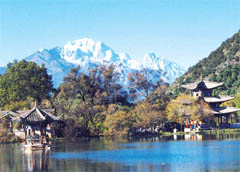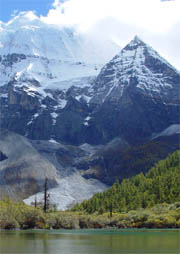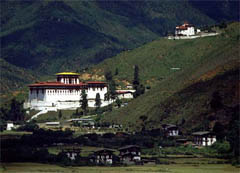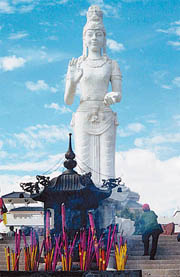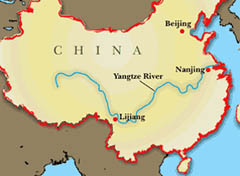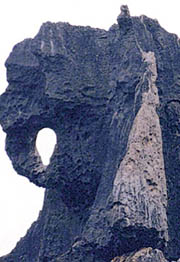|
Shangri-La On Trail of Real Shangri-La
By Dominick Merle LIJIANG, CHINA — Is this city the mythical come true? You might have a hard time convincing the old farmer hoeing his field for 12 hours a day, but city officials have been bold enough to rename the main thoroughfare Shangri-La Road. And the upscale Shangri-La hotel chain is eyeing property in the area, something it does not do unless it can spot well-heeled travelers on the horizon. I came here to find out what all the fuss was about and left with the conclusion that if this is not the elusive La-La Land ... well, we'll get to that later. First, a little geography. Lijiang is well off the usual tourist route, situated in Yunnan Province in southwest China. A day's drive to the south is the Golden Triangle of Burma, Laos, and Thailand. Drive north for a day and you enter Tibet.
But he added that it was located
near "the loveliest mountain
on earth" where people of many ethnic backgrounds
live in perfect harmony.
He didn't know it at the time (or did he?) — and there are no records of his ever visiting here — but he pretty much painted a picture of Lijiang. This ancient city lies in the shadow of the 18,300-foot Jade Dragon Snow Mountain in the lower Himalayas. It is one of the most beautiful mountains anywhere — its 13 jagged peaks are snow-capped year-round.
But if Hilton never set eyes on the place, how could this be his Shangri-La? Enter American botanist and writer Joseph F. Rock. This is where the plot thickens, bordering on (yikes!) hints of plagiarism. Mr. Rock was leader of the National Geographic Society's Yunnan Province Expeditions. He published a series of articles, accompanied by scores of photographs, between 1924 and 1935, many of them describing the history, culture, landscape, and religions of the Lijiang area. Hilton's book was published in 1933. You do the math, the locals are quick to say. The evidence is circumstantial and close, but still no cigar. The verdict is yet to come.
But hold on. If this sounds a lot like Shangri-La or perhaps Camelot, you're quickly jolted back to reality by the scores of street vendors hawking fake Rolexes, Gucci bags, and the like. I bought a knock-off watch and got back some phony Chinese money in change. Hilton never described anything like that in "Lost Horizon." I spent a memorable evening in Old Town at a concert of ancient music performed by members of the Naxi ethnic group. Wearing colorful robes and sporting Confucius-like beards, about 30 musicians, average age perhaps close to 70, played a type of music called Dongjing, which was popular among the elite during the 16th century. The instruments were strange and
colorful, parts of them
made from animals and reptiles. While the ancient
music was literally foreign
to my untrained ear, the sight of these seniors
carrying on the tradition
was both uplifting and entertaining. The group was
established in 1987
to preserve Dongjing music and has performed
throughout Europe.
To get to Lijiang, one must fly from either Beijing or one of the other major cities of China to Kunming, the mile-high capital of Yunnan Province. Kunming is known as the City of Eternal Spring. The climate is mild, the skies are clear, and flowers bloom year round. Historically, Kunming was a gateway to the famed Silk Road. Today, it is a clean, uncluttered city of some 800,000 residents that represent 26 ethnic nationalities. The Chinese have a flair for colorful names, and a mountain on the outskirts of Kunming is called Sleeping Beauty Mountain. But this is more than color; the peak actually looks like a sleeping beauty, as though it were carved to fit the description. Lijiang is 40 minutes by air northwest of Kunming. In addition to its charming Old Town and cable-car ride to the top of Jade Dragon Snow Mountain, Lijiang can also be a base to view the Tiger Leaping Gorge, the first gorge of the Yangtze River system. Legend has it that a tiger, aided by a large rock in the center of the turbulent river, leaped from one side of the gorge to the other. One of Yunnan Province's other major attractions is the Stone Forest, which lies east of Kunming. The 200-acre site contains limestone peaks ranging in height from about 10 to 100 feet.
But while Tiger Leaping Gorge and the Stone Forest are bona fide attractions in their own right, tourism officials are banking on Lijiang to woo the tourists of the 21st century. So now we try to answer the question: Is this the place Hilton was talking about in "Lost Horizon"? Maybe. A few other spots in the world also like to call themselves the one and only Shangri-La. Both Pakistan and Tibet have candidates, and there's another claim being made right here in Yunnan Province, from the small city of Diqing. Let's give Webster the last word. He
called Shangri-La
"any hidden paradise." That doesn't sound as if you
could find it on a
map. That sounds more like a place in the heart.
The above article is from The
Christian Science Monitor.
|
||||
| FAIR USE NOTICE: This page contains copyrighted material the use of which has not been specifically authorized by the copyright owner. Pegasus Research Consortium distributes this material without profit to those who have expressed a prior interest in receiving the included information for research and educational purposes. We believe this constitutes a fair use of any such copyrighted material as provided for in 17 U.S.C § 107. If you wish to use copyrighted material from this site for purposes of your own that go beyond fair use, you must obtain permission from the copyright owner. | ||||
| ~ MENU ~ |
